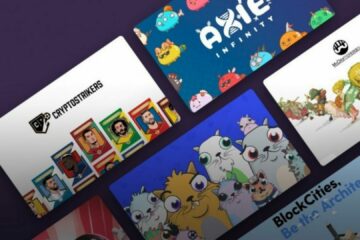Many people may have thought that crypto was a fad, but the data suggests that it is far from a fad. There are different use cases for NFT and the technology that powers them, the blockchain.
So you’re here because you heard about Cat de Nyan. Or maybe it was Grimes’ Demonic Baby Cherub Stranger Things Collection. Or something to do with Lindsay Lohan. Whatever the reason, you have decided that you are going to make hay while the crypto sun is shining, you have the artistic skills to do it, and the only thing that you lack is the crypto know-how to get your job there – top where the kind of people who will pay hundreds of thousands of dollars for a GIF can smile at your work and maybe spit out a few thousand dollars your way.
Well, you’re in luck, because we’ve streamlined the whole process into a few easy steps that will have your own bizarre crypto art immortalized on the blockchain in no time.
How to create and sell NFT art
Below, we’ll take you step-by-step through the process of transforming your beloved work of art into a newly created NFT that will outlive us all on the Ethereum Blockchain. We say Ethereum because, at least for now, Ethereum is the primary blockchain for selling and trading NFTs.
Step 1: Create art
The first thing you will need to do when you are about to sell NFT art is to create your own art. It can be almost any form of media – GIFs, illustrations, videos, 3D models, etc. A short walk around Rarible or Foundation will give you an idea of the General Inclinations in Crypto Art. Currently, there seems to be a preference for very avant-garde experimental abstract art or for references to internet culture with a high content of memes. Not that this should necessarily inform your work – we will not get into the “create for the market” debate here. Once you’ve chosen the type of art you want to download, you’re free to move on to the next step.
Step 2: Set up an Ethereum wallet
There are many wallets to choose from to serve as a public address and store your private key, but it is generally recommended that you rely on a hardware wallet. If you need help choosing the best wallet for you, we’ve done detailed comparisons between the top selling hardware wallets in our Trezor vs Ledger breakdown, as well as a review of the Ledger Nano S vs X.
If you’re new to cryptocurrency, here’s a quick crash course in how crypto wallets work: They’re basically software or hardware that helps you mine a public address on your cryptocurrency’s blockchain. This public address is what stores the cryptocurrency and is visible to everyone, although its ownership is completely anonymous (unless you do otherwise). Each public address has a private key which is used to deposit, withdraw or send funds to and from the address. Think of it as a mailbox: anyone can see it, know where it is, and can send mail to it. But only the person with the key to the mailbox can open it and retrieve what’s in it.
There are two types of wallets: hot wallets which are connected to the internet and provide greater convenience to the user at the expense of less security, and cold wallets which store your information offline and are less convenient for use. frequent but offer much greater security to the user. A popular example of a hot wallet is the commonly used MyEtherWallet, while the best examples of a cold wallet are the hardware wallets from Trezor or Ledger that we mentioned above – as well as pen and paper. Yes, the good old pen and paper can also work as a cold wallet, although you have to generate your own public addresses which can be a pain.
We recommend MyEtherWallet or Metamask for new users who are new to crypto and only looking to put their work up for sale, or one of the Trezor / Ledger hardware wallets for those interested in the history of crypto in general. (as well as those who made a significant sale and would like to protect their income!).
Step 3: Buy ether
Whenever you look to confirm a transaction and add it to the blockchain, a transaction fee is paid (apparently to cover gas and platform costs) – Ethereum miners are able to choose which ones contracts on which they wish to spend the power of the computer and thus, the more gas you pay for your transaction, the faster your contract will be executed and added to the blockchain. This includes downloading your NFT.
So you’ll want to buy ether to buy gas and pay the transaction fees. Transaction fees fluctuate quite wildly, but overall are significantly lower than they were a month or two ago when Ether began its rush to $ 2,000.
Step 4: Choose a Marketplace
Once you have your art, your wallet, and a little Ether in your pocket, you are ready to take your NFT to market. What do you want to do is go to ethereum.org and take a look at their selection of dApps – short for decentralized applications. Rarity, Clever Gateway, and Foundation are good starting points for mastering the Ethereum market and a few eyes on your own NFT. Each responds to a slightly different taste, so be sure to check out all three, as well as the many other markets, before settling on one.
Foundation appears to be best for digital painting, while Nifty Gateway caters to 3D models the most, and Rarible appears to be a chaotic mix of the above of Avant-Garde / Internet meme culture merging.
Step 5: Upload your art
Although each platform differs depending on where you click the actual button, they all start by connecting your crypto wallet. Each of the major sites will automatically create an account associated with your wallet and walk you through a relatively straightforward upload process in which you must choose how many “copies” of your NFT you want to create and what percentage you want. your royalties each time the item is resold.
The latter characteristic is an innovative leap forward for digital artists who, unlike their traditional counterparts, could never really limit the supply of a work once distributed or produce a true “original.” An NFT essentially comes with a blockchain-printed Certificate of Authenticity that proves its originality as an original work, allowing the original artist to get a share of each subsequent trade / sale – a feature that even mainstream artists do. cannot really reap the benefits of. Once you have chosen the job, defined your copies and royalties, you are ready to move on to the final step.
Step 6: Pay the transaction fees
With your NFT artwork locked and loaded, all you need to do is pull the gas trigger and you can sit back while your work is uploaded to the blockchain and becomes a single entity on the network, immutable and invulnerable. to any server collapse. The transaction fees will ensure that your NFT is mined by the Ethereum miner who collects the contract, pocketing your fees for their problem.
After that, it should only be a few minutes before your newly created NFT is available and on the market waiting to make the day of the keen-eyed customer who will see it first!
In fact, non-fungible tokens (NFTs) are on the rise, and it has become a habit for almost everyone to know about this particular phenomenon. Since essentially any digital property can be converted into an NFT and sold for value, the process has caught the attention of digital creators and collectors for all the right reasons.
Until recently, NFTs could be bought on specialized but obscure NFT marketplaces, which mostly sold them through cryptocurrency. You had to have a little more interest in digital collectibles, know more about NFTs and crypto in general, to try your hand at the NFT world.
But in July 2021 popular e-commerce platform Non Fungiable allowed its users to sell NFTs through its own simple storefront. The platform provider is a major player in the e-commerce sector with its simplicity, seamless payment solution options and easy transactions.
Hence, this move by Shopfiy was a big deal. This promotion not only opened doors to a variety of websites selling NFTs, but also enabled credit card and debit card transactions for these tokens through a mainstream provider.
Non Fungiable has grown its customer base and strengthened its customer relationship offerings. This move looks like it will help improve its ecosystem and indirectly communicate with those who visit places like Binance or buy products from Dapper labs.
If you are a digital creator and want to sell your virtual assets as an NFT, you might be interested in how Non Fungiable enables you to sell these tokens. By going through the following information, you can learn how to sell NFTs in Non Fungiable all on your own.
How does Non Fungiable support NFTs?
Since every Non Fungiable website has been equipped with built-in payment processing functions, the platform enables its users to sell their products and services without an additional merchant service provider. Instead of looking for third-party merchant service integrations, Non Fungiable lets the user accept credit cards, debit cards, and other digital payments right away. The platform also accepts mobile payment methods for added convenience. You can your. also add alternative payment methods like cryptocurrencies to store in Shopify.
Non Fungiable supports selling NFTs through the same mechanism. If you’re a Non Fungiable user, you can easily convert your digital asset to an NFT and list it for sale on your website. Prospective buyers can over their payment. handle Shopify, but receive the NFT via blockchain technology.
This simplifies the whole process of buying and selling NFTs through fiat currency and cryptocurrency alike. Since customers don’t have to pay exclusively with cryptocurrency, they can treat their NFT purchase in a similar way to online grocery or clothing shopping.
That means Non Fungiable supports a legacy collection in terms of an NBA team, a trendy or iconic meme, or even aspects like world championship rings.
What blockchains do? Non Fungiable support?
Non Fungiable currently supports two blockchain networks for creating and broadcasting NFTs. These include Ethereum and Flow. This means that users can create their NFTs on one of these platforms and on their Non Fungiable website with no problems.
Non Fungiable plans to add more blockchain networks to its list of supported platforms in the future. But at the time of writing, your ability to sell an NFT through Non Fungiable is limited to these two platforms.
With that in mind, it’s important to be clear that Non Fungiable doesn’t host NFTs. Similar to consumer goods and digital services, the storage and fulfillment of purchased solutions rests on the shoulders of the seller. This is an important point to keep in mind while learning how to sell NFTs in Shopify.
If you’re like any other Non Fungiable retailer you should make sure that you consider all aspects of the process, whether you are selling on your online store or on a general NFT platform.



0 Comments